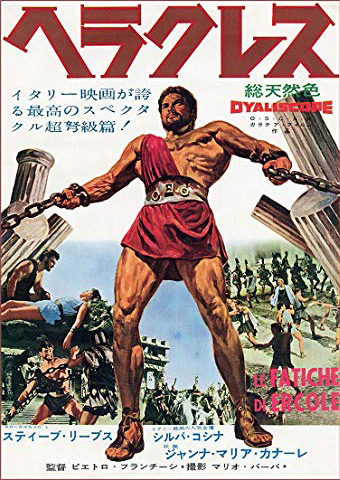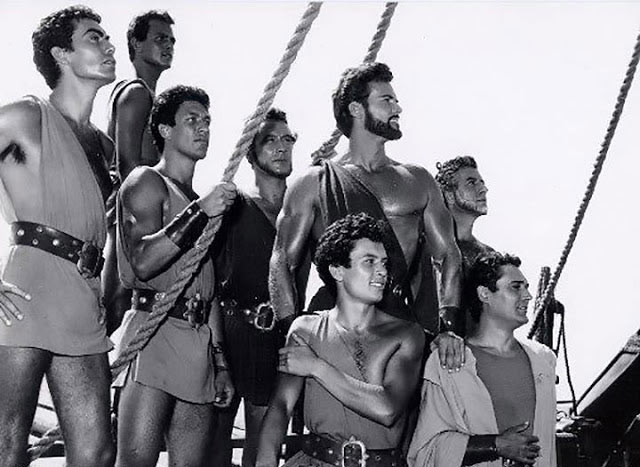
One of the aspects of the PEPLUM genre which irks me is the dismissive attitude of the success of HERCULES (1958). Many say that it became popular because of clever marketing by Joseph E. Levine. The marketing aspect for the U.S. release might be one of the reasons but not the only reason. This claim basically says the movie is worthless and that it didn’t have any redeeming qualities.
I’ll be writing about this for an article in the soon to be published magazine of BY THE GODS!.
What do you think made this movie such a success? The movie rivalled along much bigger Hollywood movies.
What is it just clever marketing? The movie is just darn good? The casting of Steve Reeves as Hercules?

Steve Reeves as Hercules and crew of the Argonaut.

Steve Reeves’ HERCULES (LE FATICHE DI ERCOLE)
LE FATICHE DI ERCOLE (1958) is my favourite Peplum movie. It’s the HORROR OF DRACULA of “Sword and Sandal” films because, like Hammer Film’s vampire masterpiece of the same year, it set the standard for all the other genre and Peplum films to come.
It’s true that some of the later films were more exciting and action-packed, like Gordon Scott’s fun GOLIATH AND THE VAMPIRES, with its over-the-top fight sequences.
But what made Hercules unique was its amazing ensemble cast headed by the amazingly beautiful Steve Reeves and Sylva Koscina, both of whom were at the top of their game and never looked better!
To my eyes, no bodybuilder actor that came afterwards, had the form or charisma of Steve Reeves. Their bodies all look bulky and exaggerated compared to Reeves’ beautifully svelte, sculpted form.
Reeves single-handedly carries the entire film, and is ably supported by some of Italy’s best character actors of the time:
Ivo Garrani and Arturo Dominici (Mario Bava’s THE MASK OF SATAN/BLACK SUNDAY).
Mimmo Palmara, the villain you love to hate, in so many subsequent Peplums (HERCULES UNCHAINED, THE LAST DAYS OF POMPEII).
Lydia Alfonsi (Mario Bava’s BLACK SABBATH).
Luciana Paoluzzi, the THUNDERBALL Bond girl.
And the technicians:
Mario Serandrei, Italy’s prolific Editor (BLACK SUNDAY, BLACK SABBATH)
The great Mario Bava, Italy’s celebrated Horror film director, working here in the capacity of lighting and special effects (and occasionally as director!).
Music by Enzo Masetti, one of Italy’s most venerable composers at the time, in one of his last film scores, and Carlo Savina (conductor of the international bestselling album of the music to BEN-HUR in 1959).
To my knowledge, no other single Peplum movie can boast of such a collection of high-powered artisans. (Except, maybe, the sequel: HERCULES UNCHAINED, which had much of the same crew.)
Joseph E. Levine’s massive marketing in North America was very successful!
The popularity of HERCULES at the time of its release in 1958, was unprecedented. The average moviegoer had never seen anyone like Steve Reeves. His body was a revelation and novelty!
Bodybuilding clubs proliferated… there was even a popular song by the folk group, PETER, PAUL AND MARY, which featured Steve Reeves in the song’s lyrics (CAR-CAR)!
Unfortunately, the dialogue for Levine’s English U.S. version of HERCULES was quite poor – with much of the voice acting sounding histrionic, and what they actually said, had the effect of making the characters sound ridiculous and the acting look bad – like a sub-par Ed Wood movie.
I believe the inept U.S. dialogue was the beginning of HERCULES’ bad reputation in North America.
(In contrast, the English dialogue of the U.K. version is more effective.)
Once HERCULES was broadcast on TV in the 1960s, it’s beautiful 2.35 widescreen was reduced to a small 4:3 Academy ratio, in black and white, further damaging its reputation.
If you listen to the original Italian version, you’ll find the voice acting to be very reasonable with none of the over-the-top histrionics of the U.S. English version.
In the present, HERCULES continues to suffer a similar fate as HORROR OF DRACULA in physical media. To this date, there isn’t an effectively restored version containing a well-balanced image with accurate colour and contrast, of either classic film. (Although, there are many inferior versions on physical media for both!)
While the Japanese Blu-ray is the best overall presentation of HERCULES (with none of the digital noise distortion inherent on the European DVDs), it is in dire need of the services of a skilled video colourist. The colour balance looks faded, and contrast is inconsistent, and virtually all of the night scenes are unwatchable with little detail, and extremely dark. It’s disturbing they released it this way!
The Japanese Blu-ray also suffers from extreme digital noise reduction eliminating any natural film grain and most of the fine image detail as well.
Also, there’s no English track, nor English subtitles, just the original Italian track with optional Japanese subs.
I’m in the process of making high quality English subs for the Japanese Blu-ray, and it’s a long and tedious job!
Despite all this, the Japanese blu-ray shows there is a viable high quality source for HERCULES out there somewhere in the world, that could be fixed properly by the work a good colourist. Such a shame that HERCULES isn’t picked up by a fine boutique label like Arrow or Powerhouse Indicator…
Looking forward to your upcoming article!